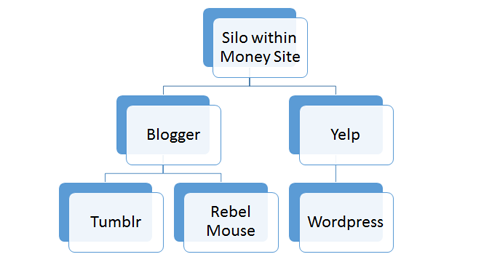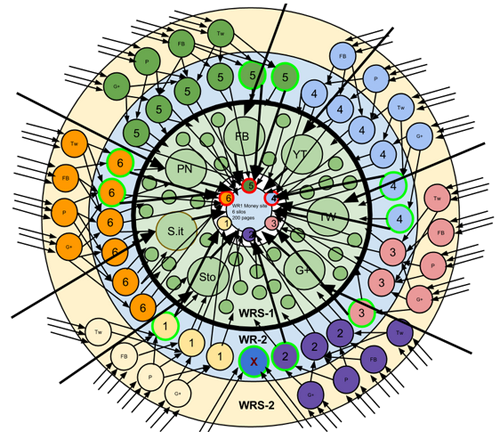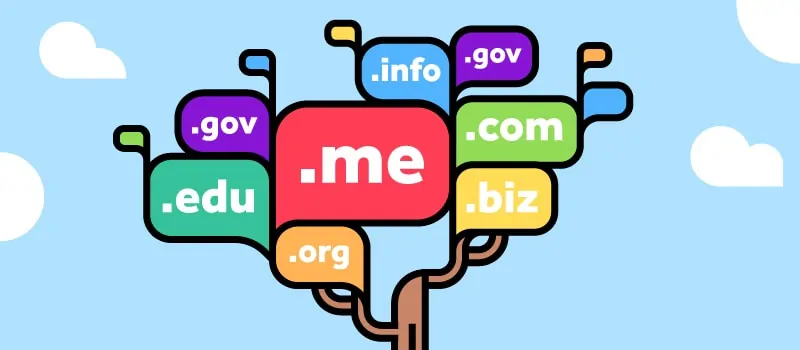Domain Authority Stacking and IFTTT Syndication Strategies

Domain Authority Stacking (DAS) is an SEO strategy developed by SEO expert Jimmy Kelly. The premise of DAS is to link multiple layers of sites together in order to pass authority to your money site.
The process of stacking authority generally involves using multiple Web 2.0 and social properties, each of which are linked randomly to sites in the above tier. Here is a simplified example of DAS in action:

As illustrated above, you can see the not all tier-3 sites link to all tier-2 sites as you would see in a traditional link pyramid.
One common practice is to boost the lower level tiers with automated tools like GSA, this is similar to the strategy used in tiered link building. Using automated links to the lower tiers helps increase the number of your sites that are indexed and can increase the page authority of the stacks. As mentioned, the outline above is an extremely simplified version of actual DAS. Here is what a full stack would look like:

Image property of Theme Zoom
Building out a full stack like the one pictured above can be rather time consuming so before taking the time to recreate this - does it actually work?
Like many things in SEO, there are people firmly for and against this technique. Some claim it works wonders and others chalk it up as hype. As noted in a recent case study by Matt Chalk, many of the proponents of DAS are people who offer or sell a service related to it. After setting up stacks, Matt recorded the following changes in his site's metrics after one month:

While it is clear that the metrics improved, that does not mean that better rankings will occur as a result as several variables exist that could prevent or accelerate ranking increases in correlation with metric increases. In the case study mentioned above, Matt did report seeing a gain in his keywords as a result of this strategy. I will let you decide if you think DAS is worthwhile but for a moment let's jump over to IFTTT and look at how it can work with DAS.
What is IFTTT?
If This Then That is a free tool that allows you to create recipes that trigger an action based on another action, for example, if you post to Facebook, share the post to Twitter. There are hundreds (if not more) of recipes that you can create using this tool, including an automated link building and DAS setup.
How Does it Tie In with DAS?
One of the recipes commonly used allows you to automatically re-post content from your RSS feed to Web 2.0 and social properties. To properly use this you have a few options for labeling the syndicated content on your Web 2.0 blog sites. The 'rel=canonical' is the best way to make sure your syndicated content does not result in duplicate content issues. If that is not an option you can set the copies of the original to no-index or at minimum, you should have a link to the original article, the last option being the least effective of the three, this can be achieved with plugins for WordPress and a few scripts for other CMS based sites. If you are not sure what that look likes just copy and paste a post from Website Magazine into a word document and you will see it at the bottom of the text.

Using the recipe mentioned above, you can create 5-10 Web 2.0 sites and each time you publish a new blog post, it will automatically post to the Web 2.0 sites. Since those sites are made up of duplicate content they are not likely to rank but they are still able to pass authority back to your money site through the links embedded in your content, which makes it even more important to link to pages on your site in the body of the article.
Since newly created Web 2.0 sites are not going to have much trust or page authority (PA), linking to them from other Web 2.0s and social profiles is needed to increase the page authority and trust. That is where DAS can come in handy. Instead of linking the stacks directly to your money site, you can create a stack below each of the Web 2.0 sites that are linking to your money site. In addition to then create the stacks, you can also build links to the lower tiers in order to increase the overall authority of each stack. If you want to avoid low-quality links on all levels, simply create a few Web 2.0 sites worthy of being linked to and do some outreach, guest posting, and broken link building to power them up.
Is this a worthwhile strategy?
Above I have just scratched the surface of what goes into domain authority stacking and content syndication strategies. If you plan to give this strategy a try you need to dig deeper into the how and why before you try this or my favorite, you can set up a few test sites and experiment with different variations of these strategies and see how it works for you.
In terms of the time, investment and potential return, domain authority stacking in the traditional since is not a technique that is needed in many cases. If you find yourself in an impossibly tough vertical or one with limited white hat link building opportunities, this may be worth considering.
Over to You
Have any of you used these techniques? Did it make a positive impact? Tell us about it below!
Author Bio
 Travis Bliffen is the founder of Stellar SEO, a Web design and marketing firm located in Marion, IL. Travis and his team are equipped to handle any size SEO project and have helped numerous businesses to date build a rock solid online presence. When you are ready for more leads and sales, it is time to get #stellarized. Connect on Facebook or Twitter @theseoproz
Travis Bliffen is the founder of Stellar SEO, a Web design and marketing firm located in Marion, IL. Travis and his team are equipped to handle any size SEO project and have helped numerous businesses to date build a rock solid online presence. When you are ready for more leads and sales, it is time to get #stellarized. Connect on Facebook or Twitter @theseoproz











